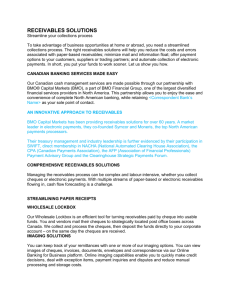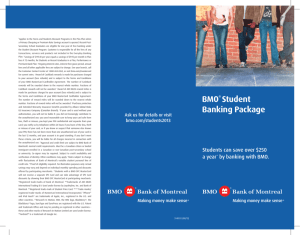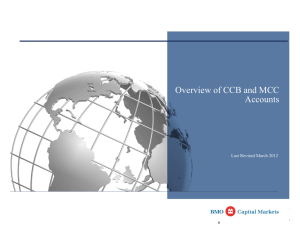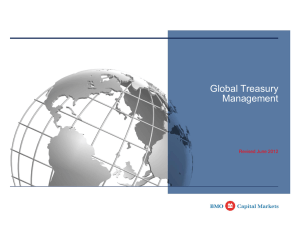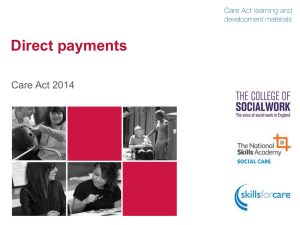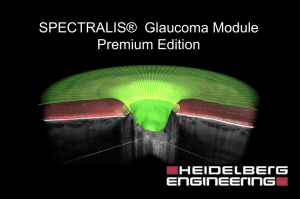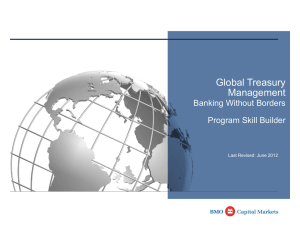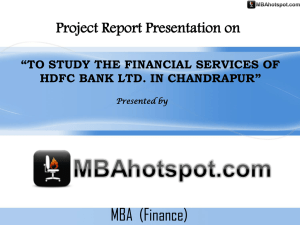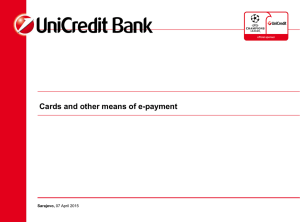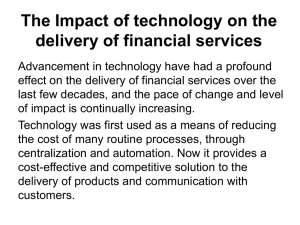Slide 0 - BMO Capital Markets
advertisement
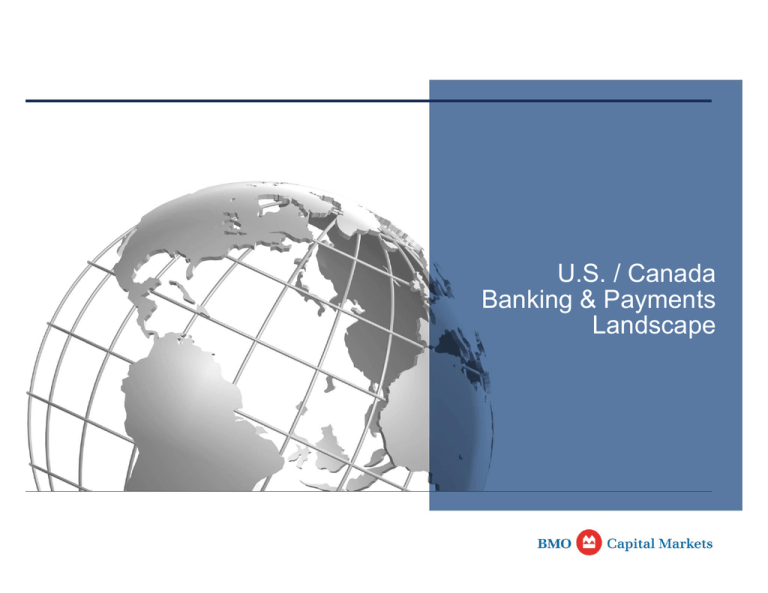
U.S. / Canada Banking & Payments Landscape Following Topics Overview of US and Canadian Banking and Clearing systems Differences / Similarities by Service Disbursements Receivables Imaging Balances Reporting Fraud Prevention 1 Clearing and Settlement System Canada's clearing and settlement system is one of the most efficient in the world Same day value across five time zones Overnight clearing Six clearing centers across the country Canada's single, centralized check clearing system is overseen by: the Bank of Canada, which provides the means for settlement; the Canadian Payments Association (CPA), which operates the national clearing and settlement systems that facilitate the flow of funds between institutions; and all deposit-taking institutions, such as the top six banks 2 Banking Facts – What’s the Difference? Canada United States Governed by the Bills of Exchange Act and the Canadian Payments Association Governed by federal and state laws – case law also impacts banking regulations Electronic payments make up the largest percentage of items cleared Checks still comprise a very large percentage of the items cleared One centralized check clearing system Various options for check clearing including the federal reserve and local clearing house arrangements Same day value for CAD items deposited across 5 time zones Multiple days for clearing (one to three is the norm) Overnight clearing of checks Defined “business day” clearing times Electronic Payments overseen by Canadian Payments Association Electronic Payments overseen by NACHA 3 Banking Systems Canada United States • Small number of large banks that branch across the entire country • Large number of depository financial institutions • A corporate customer will typically have only one primary banking relationship • The U.S. banking environment is regionalized. Corporate customers typically have multiple banking relationships • The six largest Canadian banks represent about 90 percent of total bank assets • The largest U.S. banks represent 51 percent of the total bank assets • Checks in Canada clear the same day • Checks in U.S. typically take one to three days to clear • Payments are mainly electronic • Significant usage of checks and mail-based payments 4 What Drives the Differences? Banking Services U.S. Banking Facts 8,900 financial institutions 90,000 branches and bank offices Multiple layers of regulation Federal Reserve maintains 32 check-clearing centers Several other check-clearing options are also available from other check-clearing services, or use of direct sends 5 What Drives the Differences? Banking Services Canadian Banking Facts 120 financial institutions 68 banks – 6 major banks hold 90% of assets 14,700 branches – cross-country branch network Centrally-regulated Consolidated check processing (Symcor / Intria) Canadians are the world’s largest ATM/ABM and debit card users 85% of retail banking transactions done electronically 6 U.S. Check Clearing Process 7 Canadian Check Clearing Process 8 Differences / Similarities: Disbursements • Checking accounts – No significant difference in the basic checking account services • Controlled Disbursement Accounts (CDAs) – Controlled Disbursement is unique to the U.S – Used to help determine daily funding position • Electronic Data Interchange (EDI) – Similar in both countries – EDI payments use the North American ANSI standards on both sides of the border • Wire payments – No significant difference in the basic wire services – U.S. RTGS is operated by Fedwire – Canada LVTS is operated by the CPA • Stop Payments – In the US, UCC identifies that stop payments expire after 6 months – Some FIs offer longer term options – In Canada, there are no similar regulations. It is left to the individual FI 9 Differences / Similarities: Disbursements • Check value – In Canada the maximum amount that can be paid to one party by check in any given day is $25 Million – In the U.S. our operational limit is $99,999,999.99 • Payroll cards – In the U.S., this service was made available primarily due to the needs of workers in the U.S. who do not have bank accounts • “Backdating” – Backdating of transactions is a common practise in Canada (for example: service charges, interest charges, returned checks), whereas in the U.S. it is rare • Procurement Cards / Purchasing Cards – Offerings are very similar between countries in terms of service offerings from the banks – However, there is higher use and growth of this service within the U.S. 10 Differences / Similarities: Receivables • Nation-wide deposits / float – The most significant difference between the two countries is float – In Canada you receive same day value for your deposits – In the U.S. you receive ledger credit immediately; collected funds for checks deposited take between 1 to 3 days • Mail delivery – Canada we receive mail once per day, and in the U.S. mail delivery for wholesale lockbox activity typically occurs 18 or more times per day • Lockbox – Available in both the U.S. and Canada – Is more prevalent in the U.S. partly due to the multiple mail deliveries per day, and because of the drive to reduce mail and check clearing float 11 Differences / Similarities: Receivables • Electronic Funds Transfer (EFT) payments / Automated Clearing House (ACH) payments – In Canada you can not forward much more than the payor’s name – In the U.S. depending on the type of ACH, the amount of information that can be transferred can be fairly substantial – In the U.S. there are a number of different payment types and applications for debits and credits • Electronic Data Interchange (EDI) formats – Virtually identical on both sides of the border. The EDI is a North American standard – Settlement occurs in a different manner • Incoming wire payments – Very similar on both sides of the border 12 Differences / Similarities: Receivables • Merchant services - debit & credit card – Debit and credit cards are available, to companies both in the U.S. and Canada – A key difference is the apparent complexity of the pricing or discount structure in the U.S. • Check conversion (ARC, POP, BOC) – Check conversion is the process of converting a check into an ACH payment – Only available in the U.S. – Limited to consumer checks less than $25,000 only • Deposit capture (Check 21) – Scanning the checks and electronically forwarding the images and information to your bank – Replaces the process of depositing the checks at your bank or having the checks sent to a lockbox – The introduction of Check 21 has allowed U.S. banks to introduce this service – With the move to TECP, remote deposit capture will also be available in Canada in the future 13 Differences / Similarities: Balances • Interest on credit balances – In the U.S., interest can not be paid to corporations on business checking accounts – In Canada, interest can be – and often is – paid on your daily credit balance • Earnings credits – In the U.S., a customer receives an earnings credit on their average collected bank balances – The allowance is used to offset against your service fees • U.S. customers sometimes will use sweep services to earn interest on funds – Movement of excess cash automatically into an institutional money market fund 14 Differences / Similarities: Balances • Bank account overdrafts – In the U.S., account overdrafts are discouraged – In Canada, the bank account overdraft service is a fairly normal credit offering • Reserve requirements • Deposit insurance fees • Account consolidation vs. Sweep Arrangement 15 Differences / Similarities: Reporting – Generally Quite Similar • Bank-specific proprietary reporting tools • BAI (Bank Administration Institute) reporting • EDI information • SWIFT (not used extensively in the U.S. by corporations) and multi-bank reporting • Imaging • Balance availability reporting 16 Fraud Tools for Treasury Professionals Check Security Features Positive Pay, Reverse Positive Pay, and Payee Match Electronic Payments Check Blocks and ACH Blocks 17 Timeframes for Fraud and Returned Items Transaction U.S. Canada Altered Item Varies* 90 Days Counterfeit Item Varies* 24 Hours Forged Drawer Varies* 24 Hours Forged Endorsement Varies* Unlimited Unauthorized B2B PAD, with agreement 24 hours 10 days Unauthorized B2B PAD, without agreement 24 hours 90 days Unauthorized B2C PAD 60 days 90 days *UCC varies from state to state and timeframes can be negotiated between the customer and their bank. 18 Disclaimer These materials are confidential and proprietary to, and may not be reproduced, disseminated or referred to, in whole or in part without the prior consent of BMO Capital Markets (“BMO”). These materials have been prepared exclusively for the BMO client or potential client to which such materials are delivered and may not be used for any purpose other than as authorized in writing by BMO. BMO assumes no responsibility for verification of the information in these materials, and no representation or warranty is made as to the accuracy or completeness of such information. BMO assumes no obligation to correct or update these materials. These materials do not contain all information that may be required to evaluate, and do not constitute a recommendation with respect to, any transaction or matter. Any recipient of these materials should conduct its own independent analysis of the matters referred to herein. “BMO Capital Markets” is a trade name used by BMO Financial Group for the wholesale banking businesses of Bank of Montreal, Harris N.A. and Bank of Montreal Ireland p.l.c., and the institutional broker dealer businesses of BMO Capital Markets Corp., BMO Nesbitt Burns Trading Corp. S.A., BMO Nesbitt Burns Securities Limited and BMO Capital Markets GKST Inc. in the U.S., BMO Nesbitt Burns Inc. in Canada, Europe and Asia, BMO Nesbitt Burns Ltée/Ltd. in Canada, BMO Capital Markets Limited in Europe, Asia and Australia, and BMO Advisors Private Limited in India. BMO does not provide tax or legal advice. Any discussion of tax matters in these materials (i) is not intended to be used, and cannot be used or relied upon, for the purposes of avoiding any tax penalties and (ii) may have been written in connection with the “promotion or marketing” of the transaction or matter described herein. Accordingly, the recipient should seek advice based on its particular circumstances from an independent tax advisor. 19
